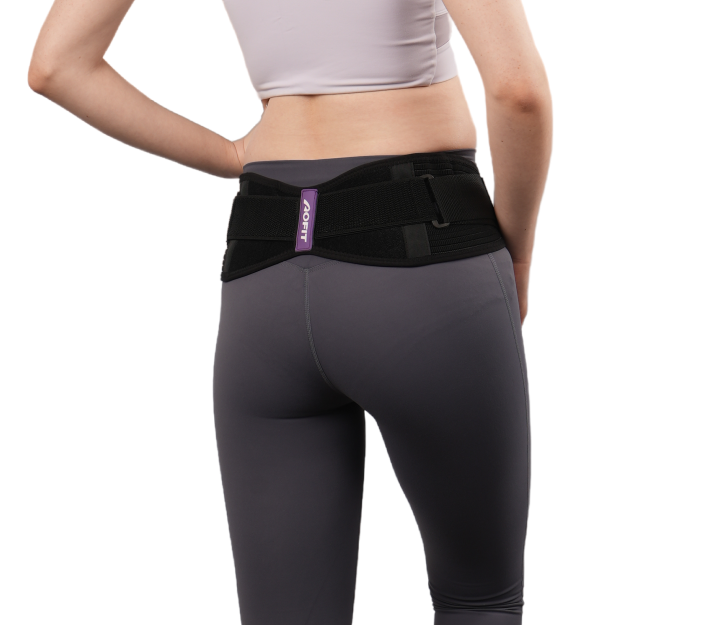-The Benefits of Using Pelvic Belts
-AOFIT: Your Trusted OEM/ODM Manufacturer
Pregnancy is a transformative journey for women, but it can also bring discomfort and challenges, particularly in the form of low back pain and pelvic girdle pain. To alleviate these symptoms and ensure a healthier, more comfortable pregnancy, many expectant mothers turn to belly bands. These stretchy, adjustable garments provide gentle support, compression, and stability to the abdomen. In this article, we will explore the importance of belly bands, and their benefits in relieving pregnancy-related discomfort, and introduce the AOFIT Brace Pelvic Binder—an exceptional product designed to offer unparalleled support and relief for pregnant women.
The Benefits of Using Pelvic Belts


1. Reduced Pain and Discomfort: The prevalence of low back pain during pregnancy ranges from 20% to 90%, with the majority of studies reporting a frequency of more than 50%. Pelvic girdle pain often begins at the end of the first trimester, peaking between the 24th and 36th gestational weeks; it usually fades spontaneously within 6 months postpartum; nevertheless, the discomfort persists in 8% to 10% of women for 1 year to 2 years afterward. Depending on the criteria, the prevalence of pelvic girdle pain in pregnancy ranges from 4% to 76%.
Pelvic belts and belly bands provide support to the lower back and pelvic area, which can help alleviate pain and discomfort associated with weight gain and postural changes during pregnancy. They help distribute the weight of the growing belly more evenly, relieving pressure on the lower back and reducing strain on the muscles and ligaments.
2. Improved Stability and Posture: The recommended weight increase during pregnancy is 11 to 16 kg, with roughly half of that growth occurring in the belly. As a result, the expanding belly causes postural compensations, which commonly result in the development of low back pain (the most prevalent musculoskeletal complaint during pregnancy) and/or pelvic girdle discomfort. Gestational low back pain usually starts in the second trimester, about 22 weeks of pregnancy. Approximately half of the women who experienced low back discomfort during pregnancy continue to have pain one year afterward, and 20% are still symptomatic three years later.
These supportive garments help promote better posture by providing gentle compression and stability to the abdominal and pelvic regions. They can help prevent excessive forward tilting of the pelvis and promote proper alignment of the spine, reducing the risk of developing poor posture-related issues.
3. Enhanced Pelvic Floor Support: Pelvic belts and belly bands can also provide support to the pelvic floor muscles, which may become weakened during pregnancy. This additional support can help reduce the risk of pelvic floor dysfunction, such as urinary incontinence or pelvic organ prolapse.
4. Reduced Strain on Ligaments: Pregnancy hormones, such as relaxin, can loosen the ligaments in the pelvic area, leading to instability and discomfort. This commonly involves low back discomfort. The prevalence of discomfort placed between the posterior iliac crest and the gluteal fold across the anterior and posterior parts of the bony pelvis has been found to range from 16% to 25%. However, the precise definition of pelvic girdle pain frequently overlaps with low back pain, making all frequency indices in the literature estimations.
Pelvic belts and belly bands provide external support, helping to stabilize the pelvic joints and reduce strain on the ligaments, which can contribute to a more comfortable pregnancy experience.
5. Active Lifestyle Support: If you wish to stay physically active during pregnancy, wearing a pelvic belt or belly band can provide extra support and comfort during exercise or daily activities. They can help minimize the impact on your joints and muscles, allowing you to maintain an active lifestyle with reduced discomfort.
6. Postpartum Recovery Aid: Pelvic belts and belly bands can also be beneficial during the postpartum period. They can help provide support to the abdominal muscles and aid in the recovery of the abdominal wall after childbirth. They can also offer gentle compression, which may help reduce postpartum swelling.
Pelvic belts are designed to provide support to the lower back and pelvis by utilizing compression and stabilization. These belts can help alleviate pain and discomfort associated with the weight gain of pregnancy, as well as offer structural support to the pelvic girdle. By evenly distributing the weight of the growing fetus across the pelvis and spine, a pelvic belt can relieve pressure on the lower back and reduce the impact of weight shifting.
Continuous and extended use of pelvic belts during and after pregnancy might be related to modifications of pelvic asymmetry in the perinatal period. Therefore, the instruction of correct and comfortable usage and the recommendation of continuous use of pelvic belt especially during pregnancy are required for prevention of some discomforts related to pelvic malalignment.
1. Understanding the Purpose of a Pelvic Belt: Pelvic belts, also known as sacroiliac belts or maternity belts, are orthopedic devices designed to provide targeted support and alleviate pain associated with pelvic instability. AOFIT's pelvic belts, meticulously manufactured using premium materials and advanced techniques, are renowned for their exceptional quality and durability, ensuring optimal performance and long-lasting comfort.
2. Assessing the Fit: Before using a pelvic belt, it is crucial to ensure the correct fit. AOFIT's pelvic belts are adjustable, allowing for a customized fit around the pelvic region. Start by positioning the belt around your hips, just below the belly button, and fasten it securely. Adjust the tension straps to achieve a snug yet comfortable fit. Remember that a properly fitted pelvic belt should provide support without causing discomfort or restricting movement.
3. Applying Correct Tension: To effectively stabilize the pelvic region, it is essential to apply the correct tension. AOFIT's pelvic belts feature adjustable tension straps that enable precise customization. Gradually increase the tension until you feel adequate support and a reduction in pain or discomfort. However, be cautious not to overtighten the belt, as this may restrict circulation or cause discomfort. Finding the right balance is key to maximizing the benefits of the pelvic belt.
4. Wearing Duration and Activities: The duration for which you wear a pelvic belt will vary depending on your specific needs and comfort level. Some individuals find relief by wearing the belt throughout the day, while others may prefer to wear it during specific activities that exacerbate pelvic pain, such as walking or lifting. Experiment with different wearing durations and assess the impact on your comfort and stability. Consult with a healthcare professional if you have any concerns or require personalized guidance.
5. Care and Maintenance: To ensure the longevity of your pelvic belt, proper care and maintenance are essential. AOFIT's pelvic belts are crafted with high-quality materials that are designed to withstand regular use. However, it is recommended to follow the care instructions provided by AOFIT, which may include hand washing or machine washing on a gentle cycle. Always allow the belt to air dry thoroughly before using it again.
AOFIT: Your Trusted OEM/ODM Manufacturer
AOFIT's commitment to excellence extends to its production of pelvic belts. As an OEM/ODM manufacturer, AOFIT leverages its expertise and advanced manufacturing capabilities to deliver pelvic belts of exceptional quality and performance. By partnering with AOFIT, businesses and brands can offer their customers access to top-quality pelvic belts that prioritize comfort, stability, and effectiveness.
pregnancy can put significant strain on a woman’s body, especially on the musculoskeletal system. Low back pain and pelvic girdle pain are common symptoms experienced by many pregnant women. Pelvic belts, like the AOFIT Brace Pelvic Binder, can provide much-needed support and relief from pain and discomfort associated with pregnancy. This supportive belt allows women to continue their daily activities without being hindered by pain and discomfort. Using the AOFIT Brace Pelvic Binder during pregnancy is highly recommended, especially for women who are prone to low back or pelvic pain, to alleviate symptoms and provide the necessary support for a healthy pregnancy. AOFIT's expertise as an OEM/ODM manufacturer ensures that their pelvic belts are meticulously crafted to deliver exceptional support and durability. By following the guide in this article, you can harness the full potential of your pelvic belt, enjoying enhanced well-being and an improved quality of life. Partner with AOFIT today and discover the transformative benefits of their premium pelvic belts.